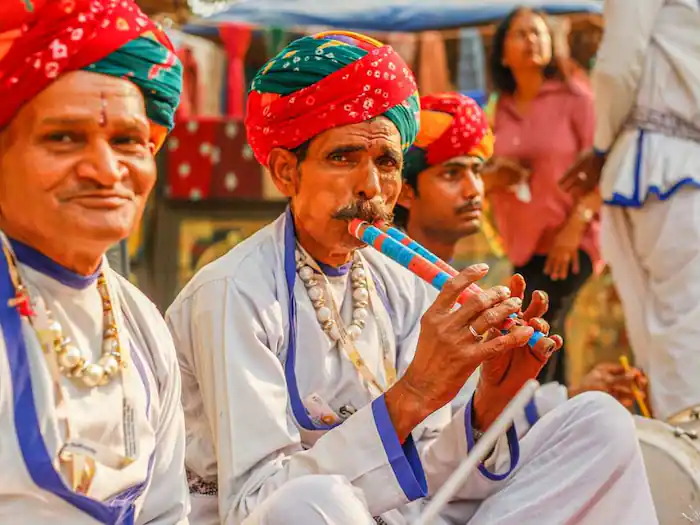Eight Things You Should Know Before Going to Bikaner
Organizing a Trip to Bikaner? Here are 8 Important Points to Remember
Northwest Rajasthani city Bikaner is renowned for its mouthwatering cuisine, magnificent forts, and rich cultural legacy. Learn the essentials before you go to this fascinating desert city to guarantee a good time. Here are several pointers, ranging from enjoying the royal heritage to comprehending regional cultures.

1. See the magnificent Junagarh Fort
The Junagagarh Fort
The majestic architecture and history of Bikaner are embodied in the Junagarh Fort.
Raja Rai Singh, a commander under Mughal Emperor Akbar, constructed it in 1589.
includes elaborate sculptures, exquisite murals, and elaborate mansions.
View the beautiful Phool, Anup, and Chandra Mahal.
Admire the magnificent gold leaf paintings, marble panels, and mirrorwork.
Extra details:
One of the few significant forts in Rajasthan that isn’t perched on a hill
has 37 bastions and a 986-meter wall that has never been overcome.
There are now galleries at sculpture and art museums to explore 2. Explore the Famous Karni Mata Temple
Temple of Karni Mata
The sage Karni Mata is the subject of the Deshnoke Karni Mata Temple.
renowned for housing an enormous 20,000 holy rats.
Rats are given sweets and grains, allowed to wander freely, and revered.
Take in the aarti rites and ask Karni Mata for blessings.
In the event that a rat runs over your foot, it are lucky.
Worshipped as a manifestation of Goddess Durga, Karni Mata
Maharaja Ganga Singh provided marble sculptures and silver gates.
Larger stature and paler hair color are indicative with older rats. Suck in some Bikaneri cuisine.
Cuisine from Bikaneri
Bikaner serves delicious Rajasthani food and desserts.
Taste the crunchy fried gram flour snack, bikaneri bhujia.
Enjoy dal bati churma, pyaaz ki kachori, and gatte ki sabzi.
Treat your sweet tooth with mohanthal, ghewar, and rasgulla.
Extra details:
Other well-known munchies include samosas, aloo tikki, and mirchi vada.
Geographical location affects flavors throughout spice trading routes.
Different cuisines were available from the royal kitchens of Lalgarh Palace and Junargarh Fort.
4. Take in the Vibrant Camel Festival
Vibrant Camel Festival
Celebrated annually, the Camel Festival honors the “ship of the desert.”
A procession of vibrantly dressed and exquisitely ornamented camels.
Camel races and events such as milking competitions.
performances of music and folk dances.
Buy products made from camel leather, fabrics, and handicrafts made locally.
Extra details:
The Department of Tourism, Art, and Culture launched it.
Things include competitions for the greatest camel decorations and camel fur cutting
More than 30,000 camels congregate from nearby areas.
5. Honor regional traditions and customs
Regional Traditions & Customs
Bikaner has a long history of complex cultural practices.
When you go touring, dress modestly and conservatively.
When you attend a place of worship, cover your legs and shoulders.
When visiting temples or other holy places, take off your shoes.
Salute with “Namaste.” Consult the locals for advice on traditions.
Extra details:
Before taking pictures of ladies, ceremonies, or sacred locations, get permission.
Making positive impressions with simple Hindi words
Remain clear of saffron flags used to indicate religious sites.
6. Learn About Gorgeous Palace Lalgarh
Palace Lalgarh
Lalgarh Palace is a magnificent example of Bikaner royalty.
Constructed in 1902 by Maharaja Ganga Singh, the enlightened king.
combines Mughal, Rajput, and European designs.
Admire the magnificent paintings, sculptures, and regal objects.
View the monuments and the collection of photographs.
Extra details:
Bikaner state was developed and made prosperous by Ganga Singh.
Architectural features made of exquisite marble, local sandstone, and Burmese teak
British dignitaries that visited the palace are shown in portraits. 7. View the Bright Gangaur Festival Events
Celebrations of the Gangaur Festival
Gangaur pays homage to the goddess Parvati, a symbol of marital bliss.
March–April: Celebrated with vibrant processions and melodies.
Traditional-dressed women carry clay pots decorated with flowers.
rites include lamp lighting, prayers, and offerings to the deity.
A vibrant cultural window into the history of Rajasthan.
Extra details:
The procession starts at the imposing Junagarh Fort. Jewelry and mehndi are used to adorn images of Gauri, or Parvati.
Women who are single are given particular advantages in marriage.
8. Be ready for Severe Weather
Bikaner has chilly winters and scorching summers.
March through June are the warmest months, with highs of 45 °C.
Avoid direct sunlight, wear loose cotton clothing, and stay hydrated.
Winters (November through February) may be quite chilly at night and in the early morning.
When going outside, wear layers of clothes and bring a jacket or shawl.
Extra details:
October through February are the best times to go.
Bring sunglasses, hats, and high-SPF sunscreen in your bag as sun protection.
Shawls and coats made of camel wool are ideal for cold winter nights.
In conclusion, a trip to Bikaner is sure to leave you with many unforgettable memories—gorgeous forts with lavish architecture, energetic festivals exhibiting Rajasthani culture, and delectable food. When traveling like a native, be sure to follow these crucial pointers to thoroughly immerse yourself in the culture.







